Influence of Carbonization Process on the Mechanical Properties of Nano-MgO Modified Cement Soil
Abstract
1. Introduction
2. Test Materials and Preparation
2.1. Materials
2.2. Test Program
2.3. Sample Preparation
- (1)
- Soil sample preparation. The subgrade soil was soaked in water for 7 days until it was softened and turned into silt. Next, large particles, stones or other impurities were removed from the subgrade soil through a sieve with a diameter of 2 mm.
- (2)
- Determination of the moisture content. The subgrade soil was stirred evenly and stood for 2–3 weeks. Then, a small amount of subgrade soil was taken out to measure its moisture content.
- (3)
- Sample mixing. Appropriate amounts of subgrade soil, cement and nano-MgO were weighed according to the experimental mix proportion, and placed into a mixer and stirred for 5 min.
- (4)
- Unconfined sample preparation. The prepared mixture was poured into a cylindrical mold with a diameter of 39.1 mm and a height of 80 mm three times. Each time the mixture was poured, it was vibrated. The sample was left to stand for 2 h after completion, and the upper and lower surfaces of the samples were flattened with a scraper, wrapped with filter paper and placed into water for curing.
- (5)
- Sample curing. The moisture content of the sample was high, so it was difficult to form; therefore, it needed to soak in water for 3 days before demolding. Then, it was placed into a standard curing box or carbonization curing box to continue curing. The curing methods and conditions are shown in Figure 2 and Table 5, and the soaking and carbonization curing are shown in Figure 3a,b, respectively.
2.4. Mechanical Test
3. Unconfined Data Analysis
3.1. Stress–strain Curve Analysis
3.2. Curve Normalization
- Determination of the average value of peak stress? .where σi is the peak stress of each stress–strain curve of the sample, and N is the number of repeated tests in this group of samples. In this study, there were five repeated tests in each group, so N = 5, and i is the serial number of the data in the sample.
- Determination of the deviation Δσi of each peak stress.
- Determination of the variance S of the peak stress.
- Determination of the initial weight pi of each peak stress. In order to ensure that the initial weight is between [0,1], the maximum value Δσimax of peak stress deviation is introduced to calculate the initial weight of each peak stress.
- Determination of the weight mapping function f(x). In the above equations, the greater the deviation of the peak value is, the greater the weight of the peak stress is. Therefore, it is necessary to assign the weight of peak stress, so that the larger the deviation of the peak stress is, the smaller the weight after assignment is. The mapping function is shown in Equation (5). As the function decreases monotonously, the greater the Δσi is, the smaller the weight after conversion is.
- Determination of the converted weight mi of each peak stress.
- Determination of the weighting factor ni of each peak stress.
- Determination of the standard value σ of peak stress.
4. Discussion
4.1. The Influence of Nano-MgO Content
4.2. The Influence of Carbonization Time
5. Ductility and Energy Dissipation Analysis
5.1. Curve Simplification
- (1)
- Elastic stage (OA section). At this stage, the pores inside the sample are compressed, the volume is reduced, and there are no cracks on the surface (Figure 14a). The contact between the soil particles is closer, and the structure becomes stronger. The stress increases linearly with the increase in strain and reaches the stress corresponding to strengthening point A.
- (2)
- Strengthening stage (AB section). As the axial load increases, the sample undergoes plastic deformation, and small cracks appear on the surface (Figure 14b). At this stage, the stress growth trend of the sample slows down and gradually reaches the stress corresponding to the peak point B.
- (3)
- Falling stage (BC section). As the axial load continues to increase, the sample shows uneven plastic deformation, and the cracks on the surface gradually spread expand to the surroundings (Figure 14c). At this stage, as the strain increases, the stress begins to decrease, and the downward trend gradually increases until it drops to the stress at point A, at which point, the stress–strain corresponds to the drop point C.
- (4)
- Failure stage (CD section). As the axial load continues to increase, the cracks on the surface gradually expand to the surroundings and are interconnected to one another to form a penetrating crack, accompanied by soil shedding (Figure 14d). The stress decreases rapidly with the increase in strain, but the downward trend gradually slows down and finally approaches a fixed value. At this time, the point corresponding to the stress and strain is the failure point D.
5.2. Ductility Analysis
5.3. Energy Dissipation Analysis
6. Conclusions and Discussion
6.1. Conclusions
- (1)
- A method for normalizing the stress–strain curve was proposed, and the normalized curve had a good correlation with the five stress–strain curves obtained through the tests.
- (2)
- Under the same carbonization time, the compressive strength of MCS first increases and then decreases with the increase in nano-MgO content. When the nano-MgO content is 1.0%, the compressive strength of MCS reaches the maximum, which is 23.4%, 13.3%, 50.2%, 41.4% and 15.0% higher than that of cement soil without nano-MgO. Under the same nano-MgO content, the compressive strength of MCS first increases and then decreases with the increase in carbonization time under five nano-MgO contents. Therefore, when the nano-MgO content is 1.0%, the compressive strength of MCS after 1 d carbonization reaches the maximum.
- (3)
- When the nano-MgO content is 0% and 0.5%, the peak strain of MCS increases with the increase in carbonization time. When the carbonization time increases from 2 d to 4 d, the increase in peak strain is smaller, so the modification effect of 2 d carbonization is optimal. When the nano-MgO content is 1.0%, 1.5% and 2.0%, the peak strain of MCS first increases and then decreases with the increase in carbonization time. When the carbonization time is 2 d, the peak strain reaches the maximum. Therefore, under five nano-MgO contents, 2 d carbonization can significantly increase the peak strain of MCS and its ductility. However, the nano-MgO content has little influence on the peak strain of MCS.
- (4)
- Under the same nano-MgO content, the energy dissipation rate of MCS first increases and then decreases with the increase in carbonization time. When the carbonization time is 1 d, the energy dissipation rate of MCS reaches the maximum under five nano-MgO contents, which can better resist the damage of external load. However, when the carbonization time is 4 d, the energy dissipation rate of MCS is the smallest, and different nano-MgO contents have almost no effect on the energy dissipation rate.
6.2. Discussion
- (1)
- In this paper, the CO2 concentration during the carbonization process is 20% ± 3%, and the influence of CO2 concentration on MCS is not considered.
- (2)
- During the curing process, the samples were carbonized in the later period of the curing, and the effect of carbonization at the early and middle stages of the curing on the test results was not explored in depth.
Author Contributions
Funding
Institutional Review Board Statement
Informed Consent Statement
Data Availability Statement
Conflicts of Interest
References
- Liu, Y.; He, L.Q.; Jiang, Y.J.; Sun, M.M.; Chen, E.J.; Lee, F.-H. Effect of in situ water content variation on the spatial variation of strength of deep cement-mixed clay. Géotechnique 2019, 69, 391–405. [Google Scholar] [CrossRef]
- Federico, A.; Vitone, C.; Murianni, A. On the mechanical behaviour of dredged submarine clayey sediments stabilized with lime or cement. Can. Geotech. J. 2015, 52, 2030–2040. [Google Scholar] [CrossRef]
- Wang, W.; Li, J.; Hu, J. Unconfined Mechanical Properties of Nanoclay Cement Compound Modified Calcareous Sand of the South China Sea. Adv. Civ. Eng. 2020, 2020, 1–16. [Google Scholar] [CrossRef]
- Jha, A.K.; Sivapullaiah, P. Susceptibility of strength development by lime in gypsiferous soil—A micro mechanistic study. Appl. Clay Sci. 2015, 115, 39–50. [Google Scholar] [CrossRef]
- Xu, B.; Low, B.K. Probabilistic Stability Analyses of Embankments Based on Finite-Element Method. J. Geotech. Geoenviron. Eng. 2006, 132, 1444–1454. [Google Scholar] [CrossRef]
- Liu, Y.; Zhang, W.; Zhang, L.; Zhu, Z.; Hu, J.; Wei, H. Probabilistic stability analyses of undrained slopes by 3D random fields and finite element methods. Geosci. Front. 2018, 9, 1657–1664. [Google Scholar] [CrossRef]
- Qiao, F.; Bo, J.; Qi, W.; Wang, L.; Chang, C.; Zhang, Z.; Wang, J. Study on the dynamic characteristics of soft soil. RSC Adv. 2020, 10, 4630–4639. [Google Scholar] [CrossRef]
- Heede, P.V.D.; Belie, N.D. Environmental impact and life cycle assessment (LCA) of traditional and ‘green’ concretes: Liter-ature review and theoretical calculations. Cem. Concr. Compos. 2012, 34, 431–442. [Google Scholar] [CrossRef]
- Lin, D.F.; Luo, H.L.; Hsiao, D.H.; Chen, C.T.; Cai, M.D. Enhancing soft subgrade soil with a sewage sludge ash/cement mixture and nano-silicon dioxide. Environ. Earth Sci. 2016, 75, 619. [Google Scholar] [CrossRef]
- Ghasabkolaei, N.; Janalizadeh, A.; Jahanshahi, M.; Roshan, N.; Ghasemi, S.E. Physical and geotechnical properties of cement-treated clayey soil using silica nanoparticles: An experimental study. Eur. Phys. J. Plus 2016, 131, 134. [Google Scholar] [CrossRef]
- Jongpradist, P.; Jumlongrach, N.; Youwai, S.; Chucheepsakul, S. Influence of Fly Ash on Unconfined Compressive Strength of Cement-Admixed Clay at High Water Content. J. Mater. Civ. Eng. 2010, 22, 49–58. [Google Scholar] [CrossRef]
- Kong, D.; Du, X.; Wei, S.; Zhang, H.; Yang, Y.; Shah, S.P. Influence of nano-silica agglomeration on microstructure and properties of the hardened cement-based materials. Constr. Build. Mater. 2012, 37, 707–715. [Google Scholar] [CrossRef]
- Mao, J.; Wu, Q.; Tao, F.; Xu, W.; Hong, T.; Dong, Y. Facile fabrication of porous BiVO4hollow spheres with improved visible-light photocatalytic properties. RSC Adv. 2020, 10, 6395–6404. [Google Scholar] [CrossRef]
- Land, G.; Stephan, D. The influence of nano-silica on the hydration of ordinary Portland cement. J. Mater. Sci. 2012, 47, 1011–1017. [Google Scholar] [CrossRef]
- Hou, P.; Qian, J.; Cheng, X.; Shah, S.P. Effects of the pozzolanic reactivity of nano SiO2 on cement-based materials. Cem. Concr. Compos. 2015, 55, 250–258. [Google Scholar] [CrossRef]
- Farzadnia, N.; Abang, A.A.A.; Demirboga, R.; Parvez, A.M. Effect of halloysite nanoclay on mechanical properties, thermal behavior and microstructure of cement mortars. Cem. Concr. Res. 2013, 48, 97–104. [Google Scholar] [CrossRef]
- Wang, W.; Li, J.; Hu, J. Triaxial Mechanical Properties and Micromechanism of Calcareous Sand Modified by Nanoclay and Cement. Geofluids 2021, 2021, 1–9. [Google Scholar] [CrossRef]
- Li, N.; Lv, S.; Wang, W.; Guo, J.; Jiang, P.; Liu, Y. Experimental investigations on the mechanical behavior of iron tailings powder with compound admixture of cement and nano-clay. Constr. Build. Mater. 2020, 254, 119259. [Google Scholar] [CrossRef]
- Meyer, C. The greening of the concrete industry. Cem. Concr. Compos. 2009, 31, 601–605. [Google Scholar] [CrossRef]
- Ruan, S.; Unluer, C. Comparative life cycle assessment of reactive MgO and Portland cement production. J. Clean. Prod. 2016, 137, 258–273. [Google Scholar] [CrossRef]
- Gao, L.; Ren, Z.; Yu, X. Experimental Study of Nanometer Magnesium Oxide-Modified Clay. Soil Mech. Found. Eng. 2015, 52, 218–224. [Google Scholar] [CrossRef]
- Gao, L.; Ren, K.Y.; Ren, Z.; Yu, X.J. Study on the shear property of nano-MgO-modified soil. Mar. Georesour. Geotechnol. 2018, 36, 465–470. [Google Scholar] [CrossRef]
- Moradpour, R.; Taheri-Nassaj, E.; Parhizkar, T.; Ghodsian, M. The effects of nanoscale expansive agents on the mechanical properties of non-shrink cement-based composites: The influence of nano-MgO addition. Compos. Part B 2013, 55, 193–202. [Google Scholar] [CrossRef]
- Wang, W.; Li, Y.; Yao, K.; Li, N.; Zhou, A.; Zhang, C. Strength properties of nano-MgO and cement stabilized coastal silty clay subjected to sulfuric acid attack. Mar. Georesour. Geotechnol. 2020, 38, 1177–1186. [Google Scholar] [CrossRef]
- Yao, K.; Wang, W.; Li, N.; Zhang, C.; Wang, L.X. Investigation on strength and microstructure characteristics of Nano-MgO admixed with cemented soft soil. Constr. Build. Mater. 2019, 206, 160–168. [Google Scholar] [CrossRef]
- Yao, K.; An, D.L.; Wang, W.; Li, N.; Zhang, C.; Zhou, A.Z. Effect of nano-MgO on mechanical performance of cement stabilized silty clay. Mar. Georesour. Geotechnol. 2020, 38, 250–255. [Google Scholar] [CrossRef]
- Yuan, H.W.; Shi, Y.; Xu, Z.Z.; Lu, C.H.; Ni, Y.R.; Lan, X.H. Effect of nano-MgO on thermal and mechanical properties of alu-minate cement composite thermal energy storage materials. Ceram. Int. 2014, 40, 4811–4817. [Google Scholar] [CrossRef]
- Hou, P.K.; Cai, Y.M.; Cheng, X.; Zhang, X.Z. Effects of the hydration reactivity of ultrafine magnesium oxide on cement-based materials. Mag. Concr. Res. 2017, 69, 1135–1145. [Google Scholar] [CrossRef]
- Liu, J.H.; Hou, F.F.; Song, S.M.; Jia, B.Y. Effects of Compressive Strength and Carbonation of HCSA Amount on High Volume Fly Ash Concrete. Adv. Mater. Res. 2011, 261–263, 333–337. [Google Scholar] [CrossRef]
- Cui, H.Z.; Tang, W.C.; Liu, W.; Dong, Z.J.; Xing, F. Experimental study on effects of CO2 concentrations on concrete carbona-tion and diffusion mechanisms. Constr. Build. Mater. 2015, 93, 522–527. [Google Scholar] [CrossRef]
- Yoon, I.-S.; Çopuroğlu, O.; Park, K.-B. Effect of global climatic change on carbonation progress of concrete. Atmos. Environ. 2007, 41, 7274–7285. [Google Scholar] [CrossRef]
- Yi, Y.; Liska, M.; Unluer, C.; Al-Tabbaa, A. Carbonating magnesia for soil stabilization. Can. Geotech. J. 2013, 50, 899–905. [Google Scholar] [CrossRef]
- Cai, G.H.; Liu, S.Y.; Du, Y.J.; Zhang, D.W.; Zheng, X. Strength and deformation characteristics of carbonated reactive magnesia treated silt soil. J. Cent. South Univ. 2015, 22, 1859–1868. [Google Scholar] [CrossRef]
- Vandeperre, L.J.; Al-Tabbaa, A. Accelerated carbonation of reactive MgO cements. Adv. Cem. Res. 2007, 19, 67–79. [Google Scholar] [CrossRef]
- Mo, L.; Panesar, D.K. Effects of accelerated carbonation on the microstructure of Portland cement pastes containing reactive MgO. Cem. Concr. Res. 2012, 42, 769–777. [Google Scholar] [CrossRef]
- Unluer, C.; Al-Tabbaa, A. Impact of hydrated magnesium carbonate additives on the carbonation of reactive MgO cements. Cem. Concr. Res. 2013, 54, 87–97. [Google Scholar] [CrossRef]
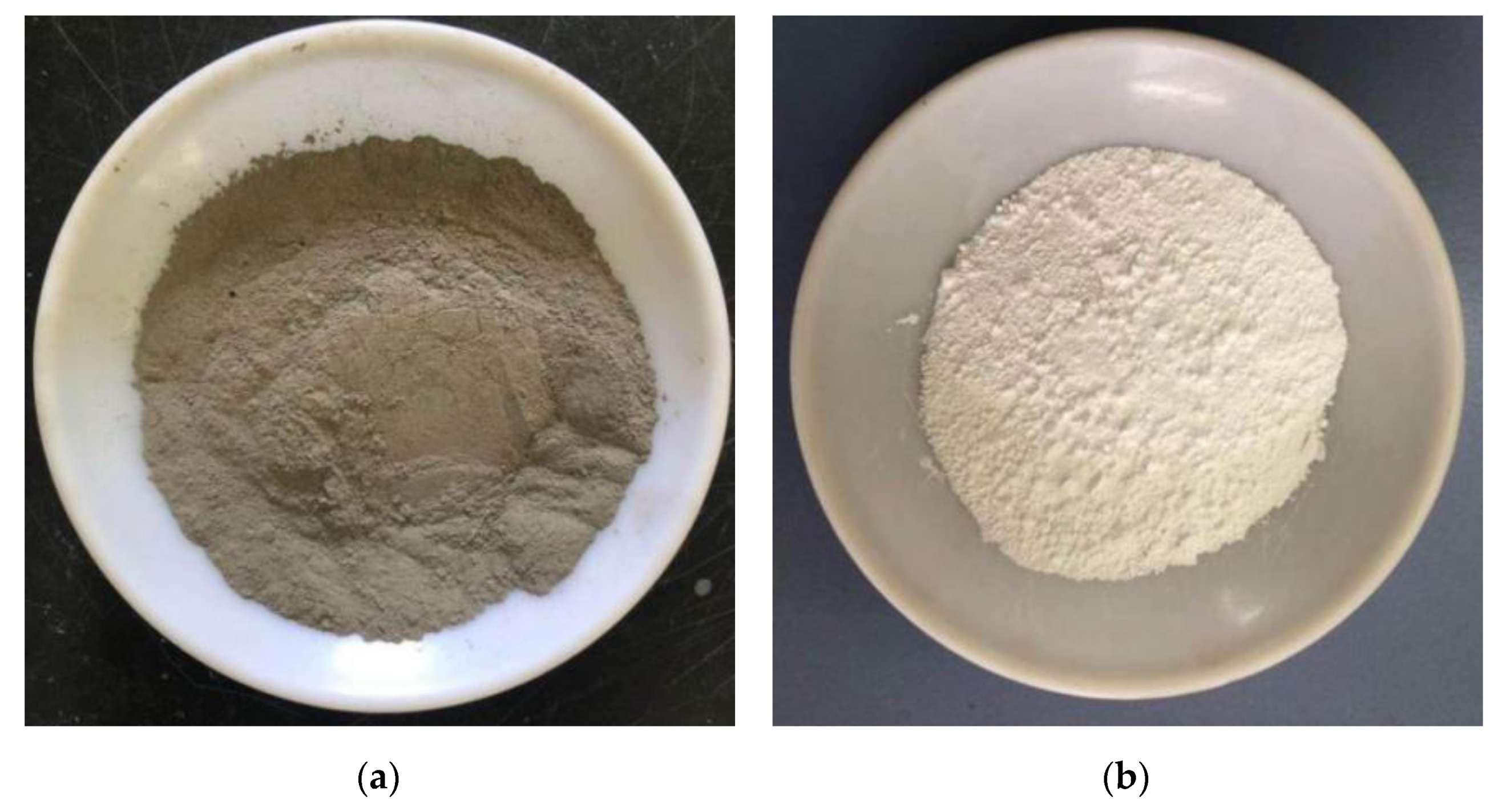
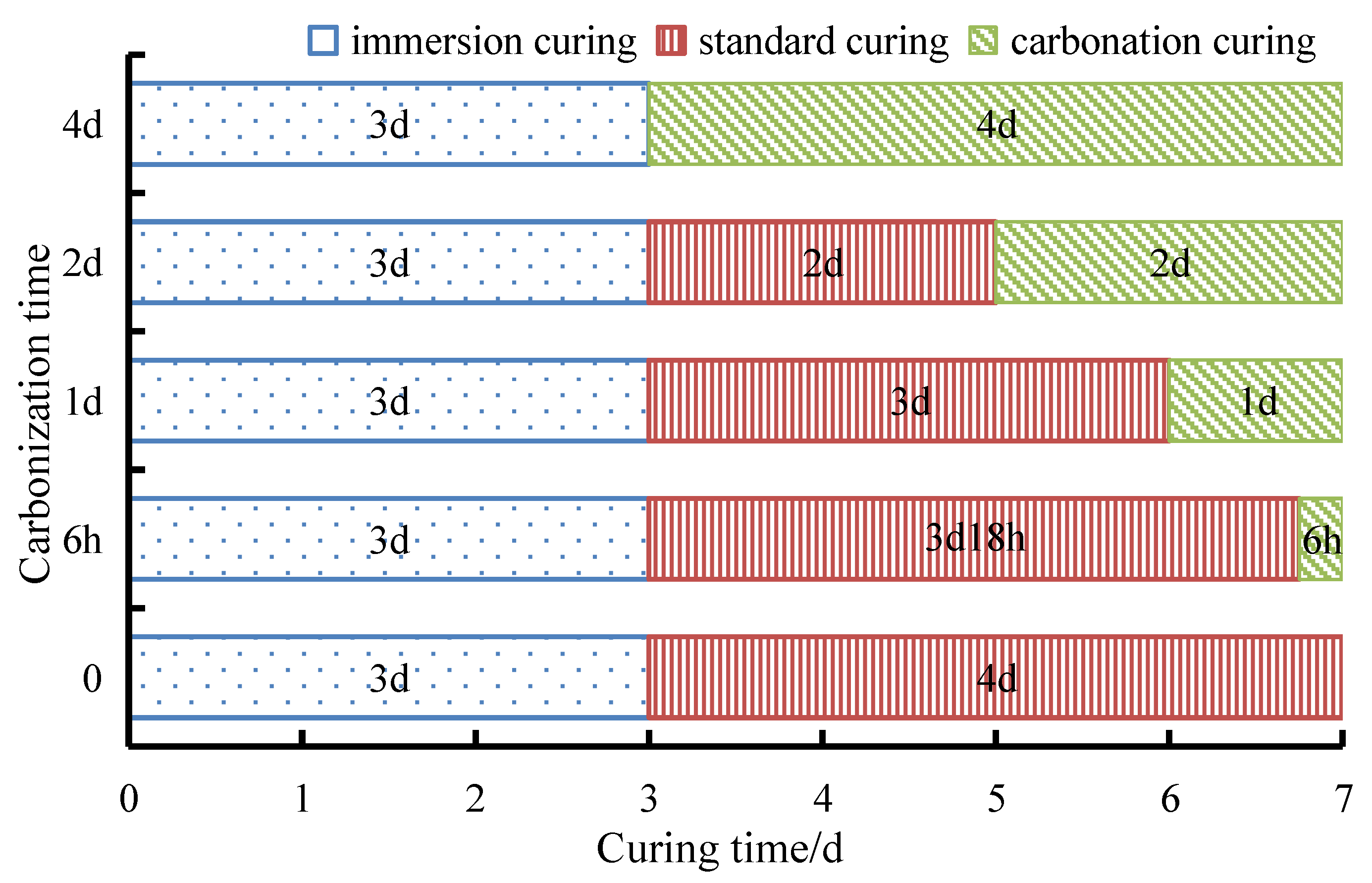


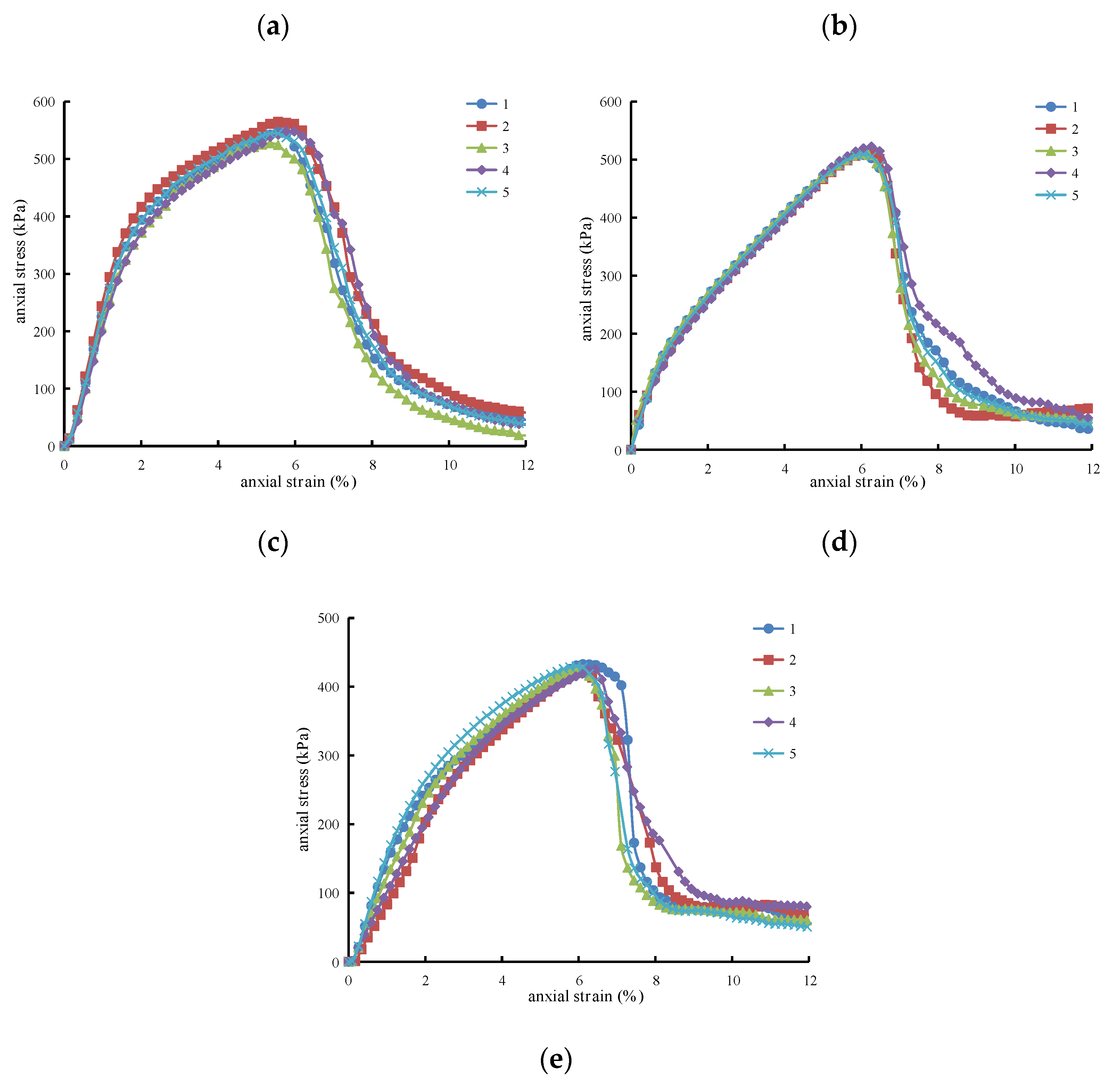

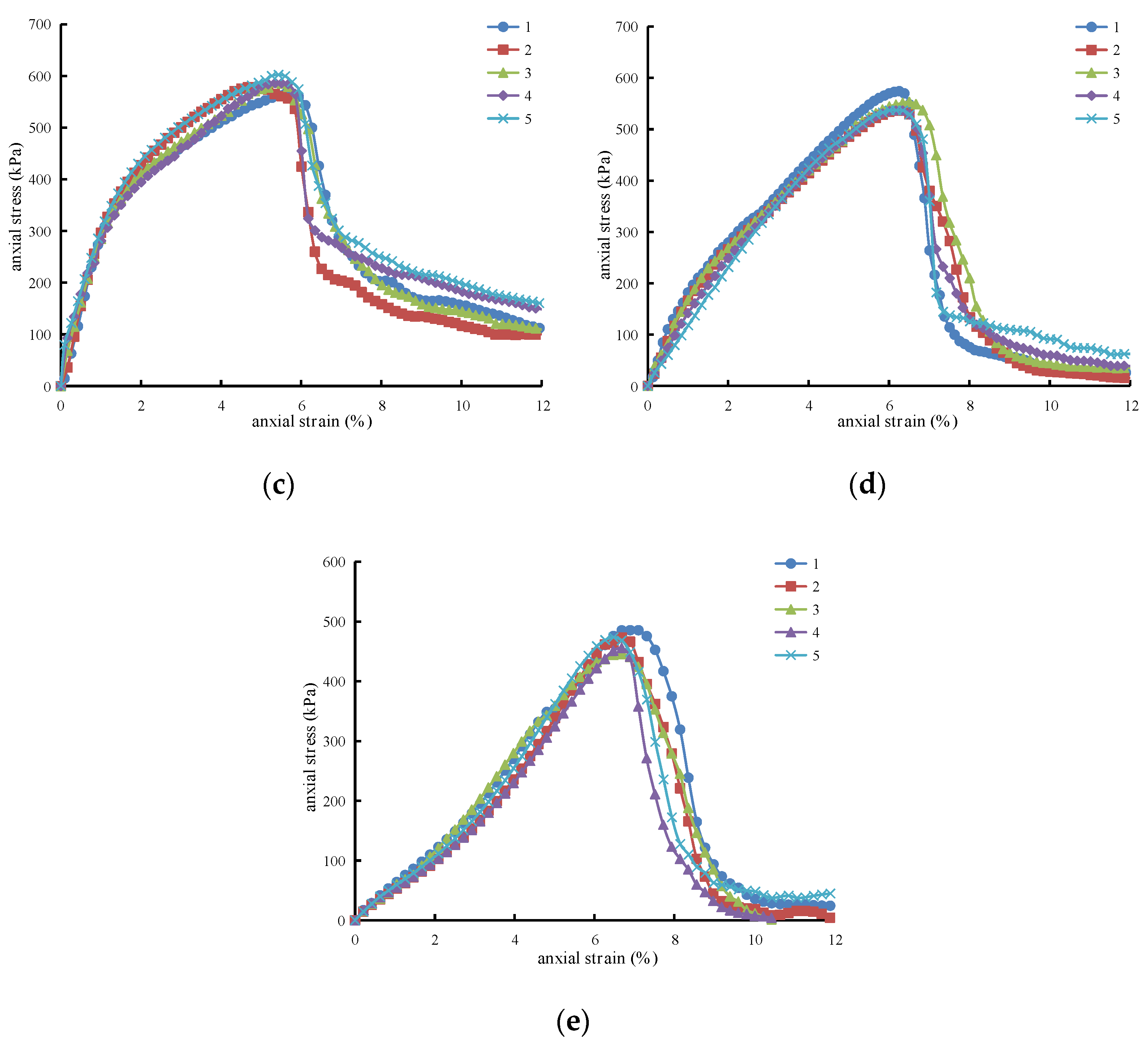

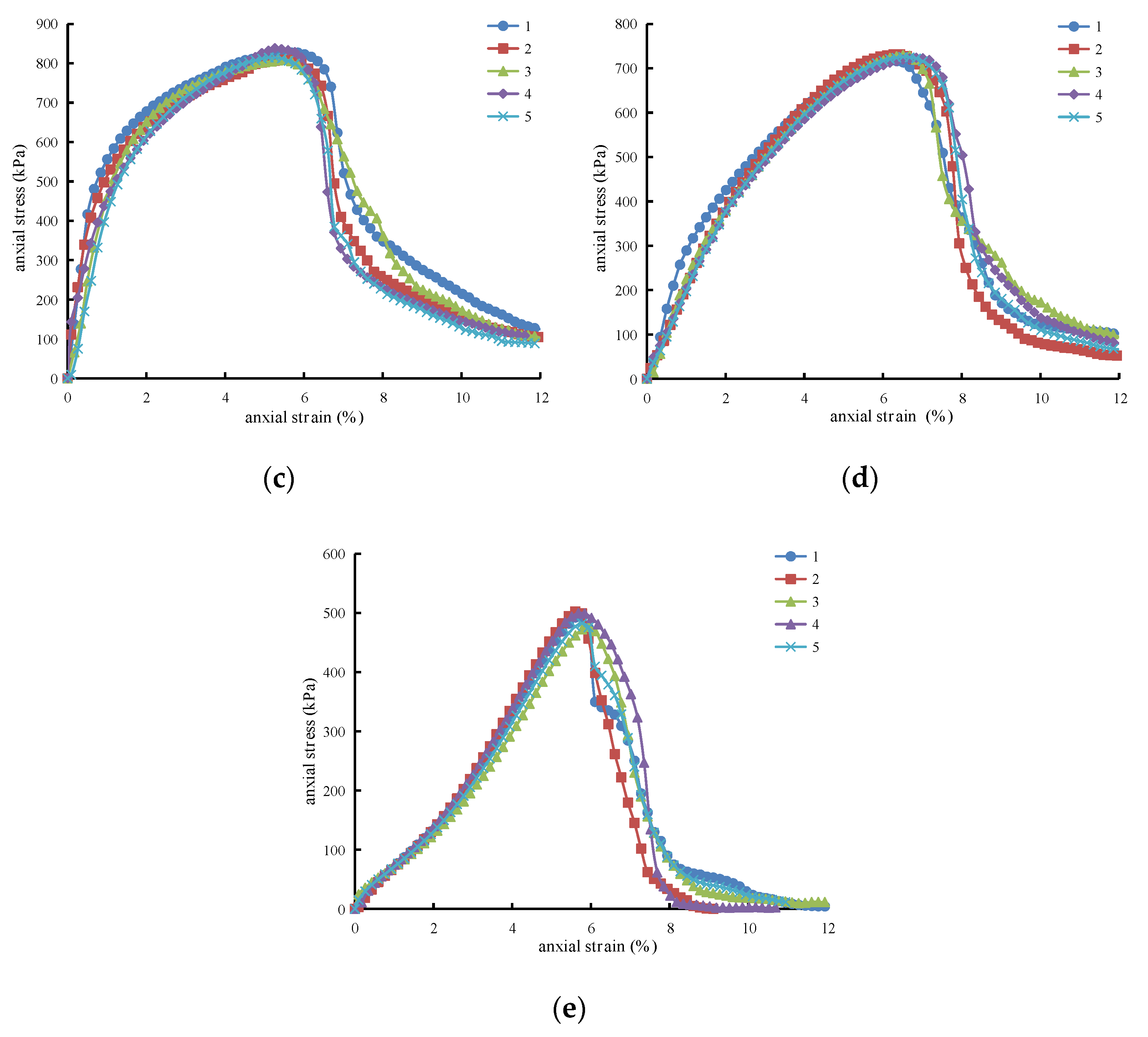

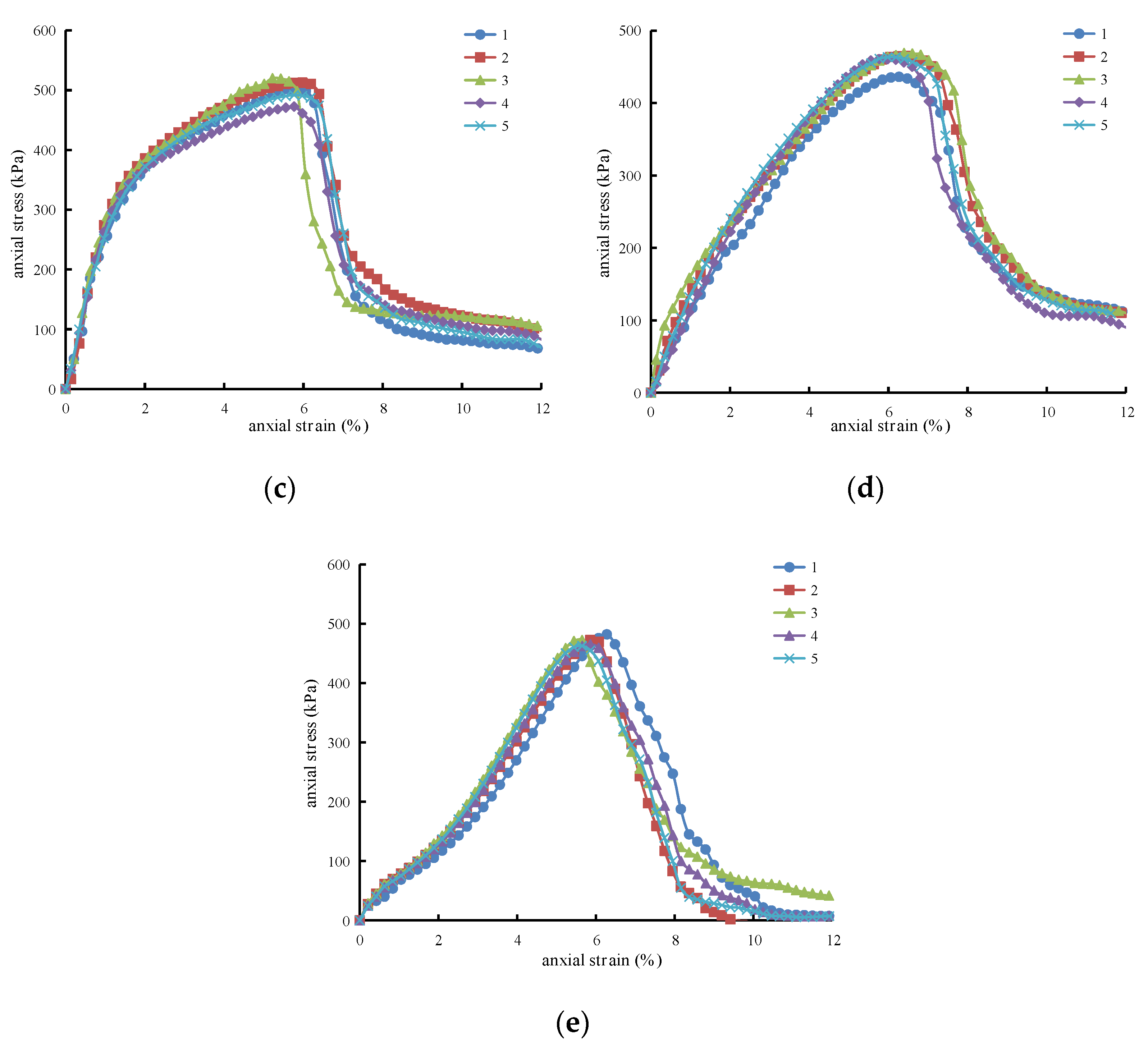



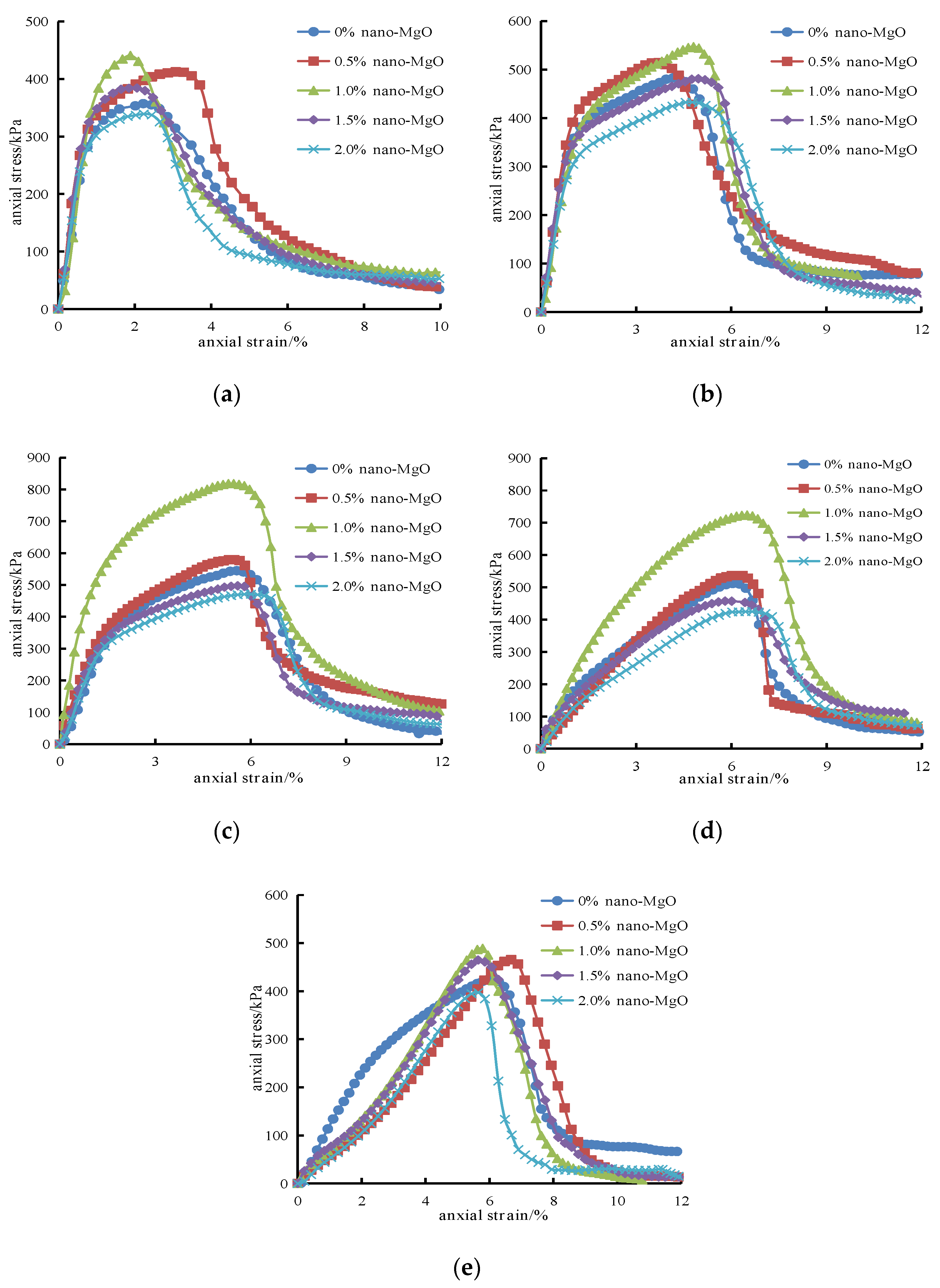
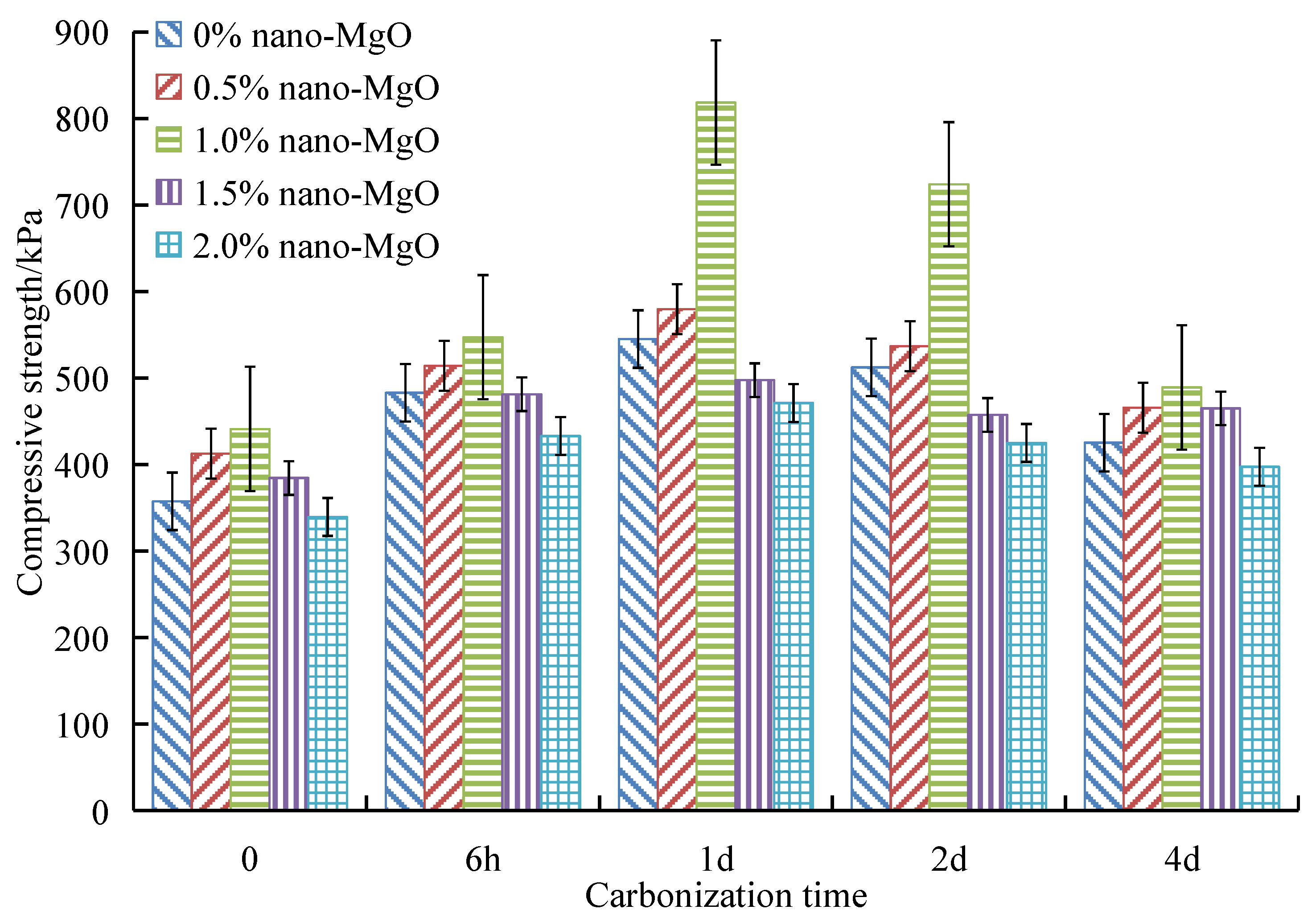

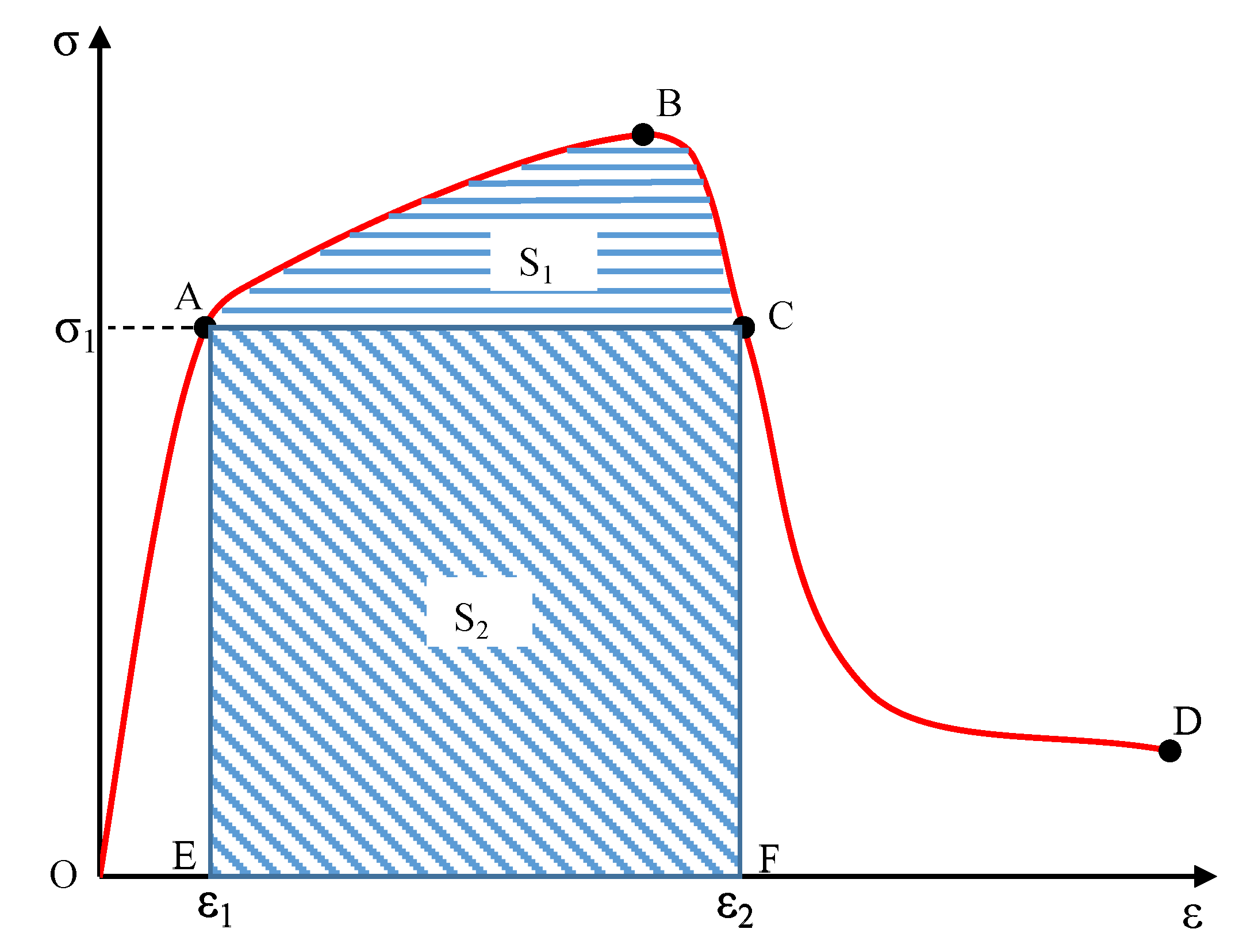
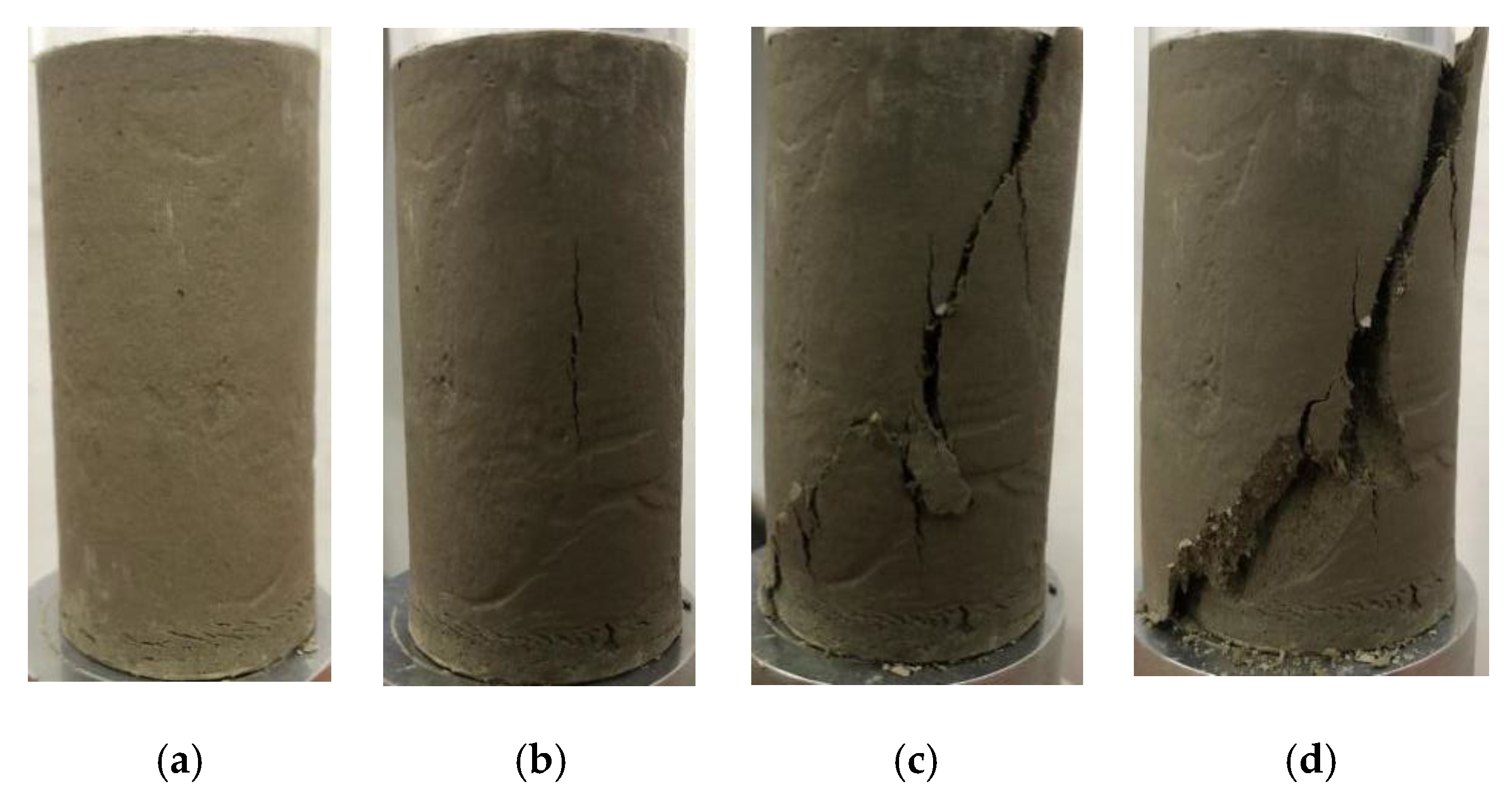

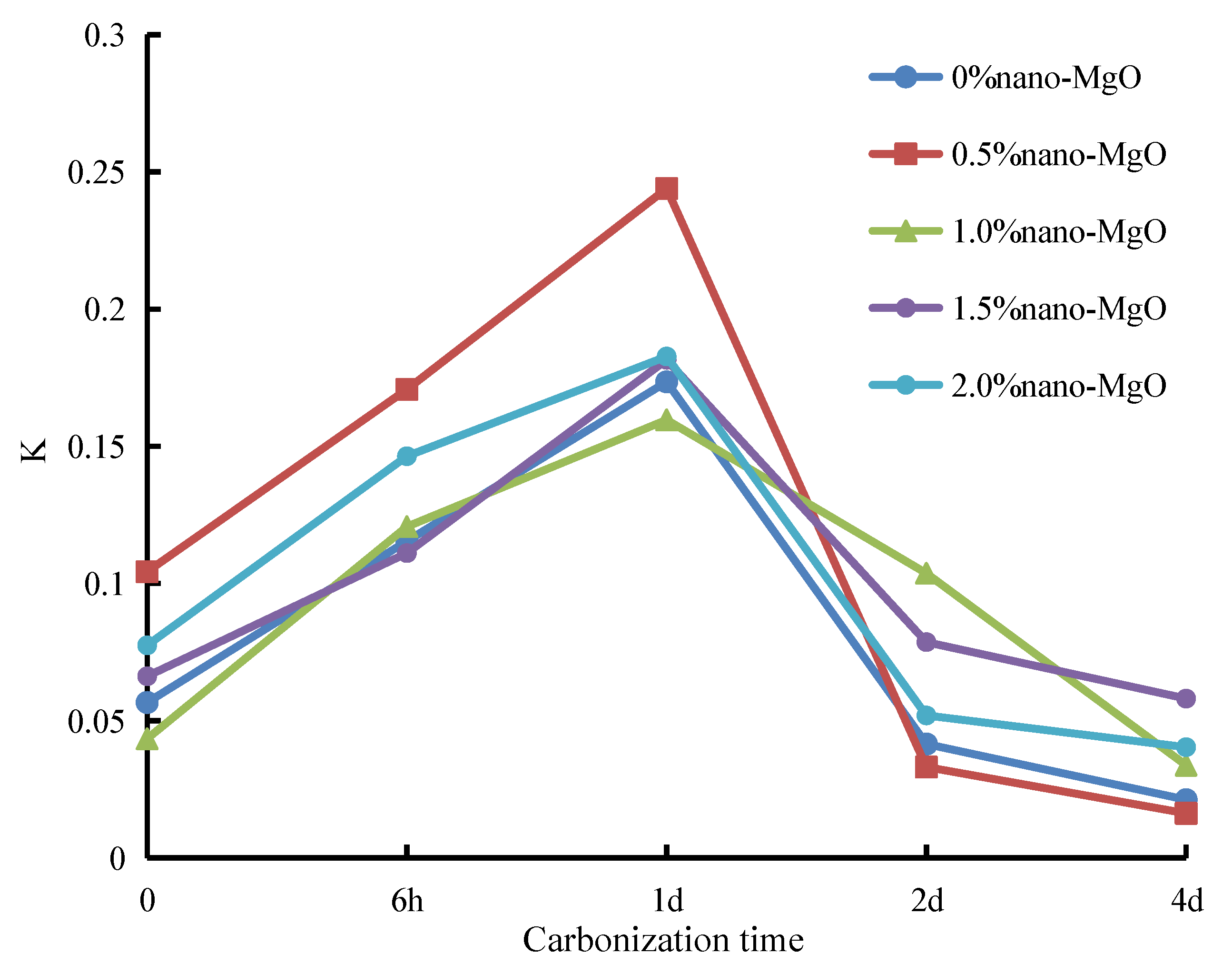
| Density (ρ/g·cm−3) | Void Ratio e | Saturability (%) | Natural Moisture Content w (%) | Liquid Limit WL (%) | Plastic Limit WP (%) | Liquidity Index IL (%) | Plasticity Index IP (%) |
|---|---|---|---|---|---|---|---|
| 1.65 | 1.64 | 98 | 60.00 | 46.20 | 26.40 | 1.70 | 19.80 |
| Fineness(%) | Stability | Setting Time (min) | Flexural Strength (MPa) | Compressive Strength (MPa) | ||||
|---|---|---|---|---|---|---|---|---|
| 0.08 mm | 0.045 mm | Qualified | Initial | Final | 3 d | 28 d | 3 d | 28 d |
| ≤10 | ≤30 | ≥45 | ≤600 | ≥2.5 | ≥5.5 | ≥10.0 | ≥42.5 | |
| Mean Grain Size (nm) | Purity (%) | Melting Point (°C) | Boiling Point (°C) | Density (20 °C) (g·cm−3) | Specific Surface Area (m2·g−1) | Refractive Index (%) |
|---|---|---|---|---|---|---|
| 50 | 99.9 | 2852 | 3600 | 3.580 | 30–50 | 1.736 |
| Group | Cement Content (%) | Moisture Content (%) | Curing Time (d) | Nano-MgO Content (%) | Carbonization Time |
|---|---|---|---|---|---|
| MCS | 20 | 80 | 7 | 0, 0.5, 1.0, 1.5, 2.0 | 0 h, 6 h, 1 d, 2 d, 4 d |
| Maintenance Method | Maintenance Conditions |
|---|---|
| immersion curing | water temperature (20 °C ± 2 °C) |
| standard curing | temperature (20 °C ± 2 °C); humidity (95% ± 2%) |
| carbonization curing | temperature (20 °C ± 2 °C); humidity (95 ± 2%); CO2 concentration (20% ± 3%) |
Publisher’s Note: MDPI stays neutral with regard to jurisdictional claims in published maps and institutional affiliations. |
© 2021 by the authors. Licensee MDPI, Basel, Switzerland. This article is an open access article distributed under the terms and conditions of the Creative Commons Attribution (CC BY) license (http://creativecommons.org/licenses/by/4.0/).
Share and Cite
Wang, W.; Zhou, H.; Li, J.; Tao, F.; Li, C.; Qian, B.; Jiang, P. Influence of Carbonization Process on the Mechanical Properties of Nano-MgO Modified Cement Soil. Sustainability 2021, 13, 3558. https://doi.org/10.3390/su13063558
Wang W, Zhou H, Li J, Tao F, Li C, Qian B, Jiang P. Influence of Carbonization Process on the Mechanical Properties of Nano-MgO Modified Cement Soil. Sustainability. 2021; 13(6):3558. https://doi.org/10.3390/su13063558
Chicago/Turabian StyleWang, Wei, Hang Zhou, Jian Li, Feifei Tao, Cuihong Li, Biao Qian, and Ping Jiang. 2021. "Influence of Carbonization Process on the Mechanical Properties of Nano-MgO Modified Cement Soil" Sustainability 13, no. 6: 3558. https://doi.org/10.3390/su13063558
APA StyleWang, W., Zhou, H., Li, J., Tao, F., Li, C., Qian, B., & Jiang, P. (2021). Influence of Carbonization Process on the Mechanical Properties of Nano-MgO Modified Cement Soil. Sustainability, 13(6), 3558. https://doi.org/10.3390/su13063558








